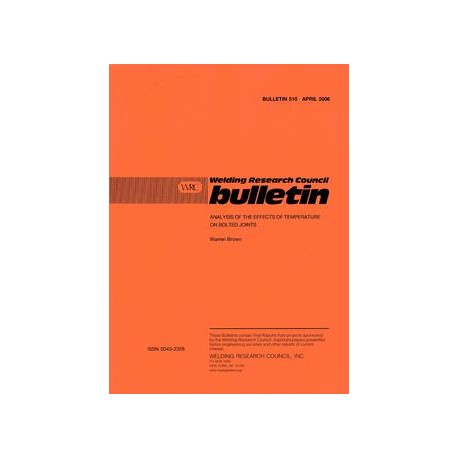Cart 0 Product Products (empty)
No products
To be determined Shipping
$0.00 Total
Product successfully added to your shopping cart
Quantity
Total
There are 0 items in your cart. There is 1 item in your cart.
Total products
Total shipping To be determined
Total
New Reduced price!  View larger
View larger
 View larger
View larger WRC 510
M00000524
New product
WRC 510 Analysis of the Effects of Temperature on Bolted Joints
Bulletin / Circular by Welding Research Council, 2006
W. Brown
In stock
More info
Full Description
Thermal events and transient thermal effects are known to play a major role in pressurized flanged joint leakage. When a leak occurs the engineering challenge is to understand and properly diagnose the role temperature and thermal transients in that failure and thereby specify measures necessary avoid future leaks. Also, since most pressure vessel codes require the consideration of thermal effects without providing the methodology, perhaps the greater engineering challenge is to the flanged joint designer. This is not only to determine temperature effects on flanged joint designs to comply with code requirements but also an evaluation of the design to assure leak free operation considering anticipated thermal events. This Bulletin provides a set of analytical tools and guidelines for addressing these challenges.The purpose of PVRC Project 01-BFC-05 was to summarize the findings of the Author's doctoral project on the effects of temperature loads on bolted flange joints and publish a summary document providing design guidelines to deal with temperature effects and the relative magnitude of these effects. Reporting on this work, the Bulletin provides users with simplified thermal calculation methods that enable the flanged joint designer or field troubleshooter to determine the effect of steady state or transient temperatures on flanged joints, including an evaluation of leakage possibilities.
This is accomplished by the author in a readable step by step process that provides the tools to answer along the way questions such as:What increase in assembly bolt load would be sufficient to overcome anticipated thermal events?-Is flange deflection caused by joint component thermal interaction sufficient to cause a leak from loss of gasket load?Could radial shearing of the gasket from differential radial expansion of the flanges or tube-sheet caused either by differences in mating flange temperatures or material properties result in failure? Is gasket crushing a possibility due to increased load caused by joint component thermal interaction? How much bolt and gasket load could be lost because of a process thermal transient, or a sudden cool-down, without failure? If insulation is applied to an operating un-insulated flanged joint, how much hotter than the flange ring might the bolts be? Is this transient sufficient cause a leak? Following an overview of bolted flanged joint response to thermal loads, causes of failure and a background description of mechanical and thermal analysis, a detailed calculation procedure is presented. For simplicity axisymmetric and generally identical mating flanges are assumed by the calculation method. Detailed guidance is then provided on extending this approach to non-identical flange pairs, joints with a tube-sheet (Heat exchanger girth joints) and coverplates. The method first provides steady state thermal and deformation results followed by means to calculate the steady state bolt load using component compliance. An evaluation of transient effects by extension of these findings and the use of a series of graphs providing the time to reach 95% and 5% the steady state temperature for each component completes the process.
Appendices A through D provide additional information on the details of the calculation methodology. Appendices E and F illustrate the calculation method via an available Excel spreadsheet.
This work culminates of over 4 years research into the effects of temperature on bolted flanged joints. The methodology provided is a simplification of an analytical method that has been verified against finite element analysis, field measurements and experimental results.

